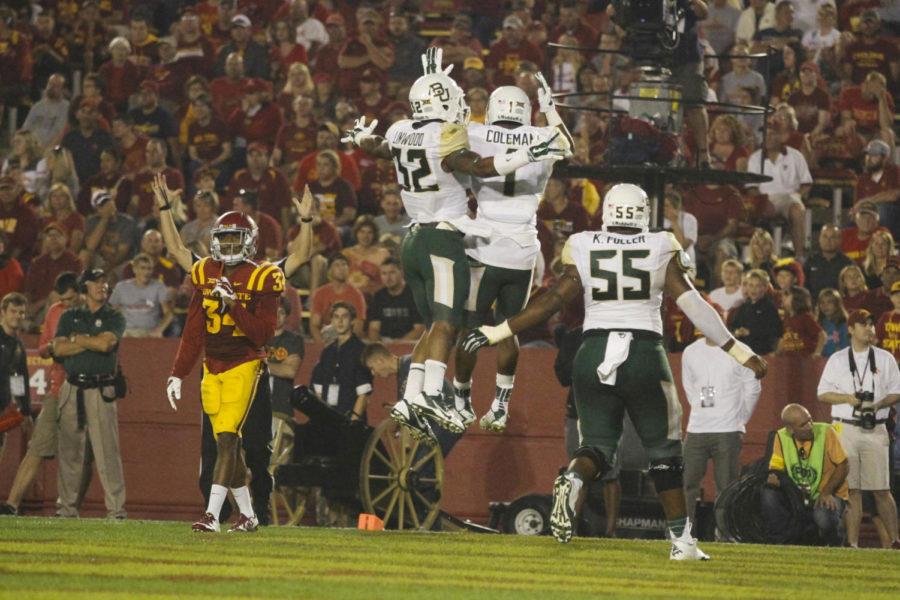Dible Overtime: Gold in the place of glory
Tiffany Herring/Iowa State Daily
Baylor players celebrate after a pass on Sept. 27 at Jack Trice Stadium. The Cyclones fell to the Bears 49-28.
November 13, 2015
The Big 12 is far from a perfect 10.
That’s certainly not to say that the conference isn’t loaded with talent. You need look no further than Iowa State’s schedule up to this point to confirm that, as No. 5 Oklahoma State will be the Cyclones’ third top-5 opponent in 10 weeks.
But in a conference with no championship game and only 10 teams, everyone plays everyone else, and things are poised to get ugly as the season winds down once again. This leaves open the very real possibility that the Big 12 champion will miss out on the College Football Playoff for the second consecutive year.
If that happens, ISU coach Paul Rhoads would be disappointed, especially having seen the depth of talent up close and personal.
“If we end up with a one-loss team, I think they belong in the playoff,” Rhoads said.
It doesn’t appear, however, that the College Football Playoff committee agrees. Baylor currently sits sixth in the playoff rankings. No. 13 Texas Christian fell last weekend to Oklahoma State and tumbled out of the top 10. The Cowboys finish their season with Baylor and No. 12 Oklahoma at home after visiting Ames on Saturday.
Oklahoma only has to roll through Baylor, TCU and Oklahoma State to finish its season with one loss, and the Bears, who currently lead the national pack in the Big 12, have Oklahoma, Oklahoma State and TCU yet to contend with.
While several scenarios could play out, it’s unlikely that any of the Big 12’s upper-echelon programs navigate the remainder of the season unscathed.
And that brings up a debate that gained a lot of momentum after both one-loss TCU and one-loss Baylor were excluded from the playoffs in the new system’s inaugural year: Should the Big 12 add two teams and re-instate a conference championship game?
Unfortunately, it’s not that simple.
“There’s multiple reasons why you would expand — financial, competitive or you’re just forced to for survival,” said ISU athletic director Jamie Pollard. “Or maybe we feel we need to do it because of the playoff. Right now, there isn’t anything out there that shows me financially that it would make sense.
“There aren’t two teams out there right now that would move the needle in anything incremental to not [decrease] the weighted profit shares for the 10.”
The Big 12 was the third-richest conference in the NCAA last year behind the SEC and the Big 10, paying out $25.2 million to each of its member schools, according to a Big 12 report.
About 80 percent of that money came from television deals with ESPN and Fox, and, in theory, adding two teams would drop each of the current 10 member school’s revenue by a little more than $4 million per season.
According to a USA Today report, Iowa State — which made more than $68 million last season — cleared just a little more than $2 million in profit after expenses, and that was almost entirely due to a $1.96 million subsidy the school received.
Assuming the numbers hold relatively similar from year to year, a $4-plus million hit wouldn’t just wipe out Cyclone profits, it’d put the athletic department in the red — unless the two schools added could make up for the losses.
“The gain wouldn’t be enough to offset the TV loss,” Pollard said. “You’re not just going to pick two schools, and each are going to come to the table and add $25 million in value so that [the Big 12] adds $50 million and stays whole. It’s not going to happen that naturally.”
Big 12 commissioner Bob Bowlsby said in June that member schools wouldn’t lose money on the current TV deal if two schools were added, and expansion into different markets if the likes Cincinnati were to join the league have the potential to boost revenues from the next TV deal — but then again, maybe it won’t.
Television isn’t the only concern, however. Revenues from bowl games, the College Football Playoff and NCAA Tournament basketball would be split immediately, so regardless of the exact numbers, the 10 member schools would take an initial financial hit, and revenue projections into the future would grow murkier.
For a school like Iowa State with such a thin profit margin, the notion is troubling. But for schools at the top of the conference, being the odd-man out of the College Football Playoff again has to be equally disconcerting.
“What caused all of this was the football playoff,” Pollard said. “Every year, at a minimum, one of the conferences is left out. It could be two if Notre Dame gets in. It could be three if two teams get in from the same league, but it’s only one year of data.
“If it came up that three straight years in a row, for whatever reason, we felt that being at 10 disadvantaged us, we may be forced to suck it up on the financial side and be forced to do this.”
But the pressure might be quicker than that, as independent Notre Dame is currently fourth in the college football poll with only one loss, and all of the Big 12’s top dogs appear poised to lose at least once, if not twice.
In the old days, voters decided who would be the national champion, even if the No. 1 team didn’t play the No. 2 team in the postseason, which they rarely did. Under the Bowl Championship Series system, there was still a heavily weighted human element, and that element has not disappeared in the College Football Playoff format.
The old mantra in college football, which should remain the new mantra, was, “if you’re going to lose then lose early.” Historical precedent makes clear that it is a fundamental human fault to more heavily weight the most recent evidence over previously accumulated evidence. How else does one explain JaMarcus Russell being the first pick in the NFL draft in 2007? I guess there’s the Al Davis factor, but I digress.
Household names and popularity are concerns as well, but if Ohio State hadn’t drubbed Wisconsin 59-0 in the Big 10 championship game last year — a chance Baylor and TCU never got — the Buckeyes would never had been afforded the opportunity to play for the national title, let alone win it.
All three of the schools had one loss, and Ohio State’s against Virginia Tech was both by the far the worst and by far the earliest.
And conference expansion from a competitive standpoint would likely only help the Cyclones. Half of their games this season have come against teams that were ranked in the Associated Press top 25 for at least one week.
Adding a non-conference game, shrinking the Big 12 schedule to eight games instead of nine, splitting up the talent into different divisions and guaranteeing that in most seasons they wouldn’t be forced to play Baylor, TCU, Oklahoma, Oklahoma State and Texas — whenever the Longhorns inevitably get their act together — means more wins for the Cyclones.
More wins means more legitimacy. More legitimacy means better recruiting. Better recruiting means more bowl games, and more bowl games means the upward spiral of success would theoretically continue — not to mention the influx of money that typically accompanies success.
Schools like Cincinnati, with either large market shares in populated areas, or Brigham Young, which garners a national following due to its religious ties among other factors, could benefit both the high-performing and low-performing football programs in the Big 12, even if they subtracted a little cash off the bat.
It’s something the conference membership must keep a keen eye on over the coming weeks, and something they must not only explore but enact if the Big 12 misses out on the College Football Playoff again come January. Another year would be too long to wait.
“You can’t have your head in the sand,” Pollard said.

















